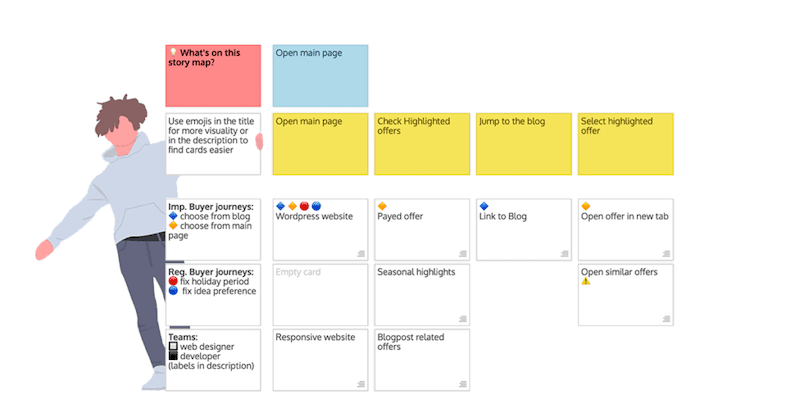It’s easy to mix story mapping up with process mapping, so we decided to provide a brief clarification on both.
Product backlogs function as the soul of a product. They are responsible for managing everything regarding the product, so they can get quite complicated.
For instance, a complex product will have many user stories in the backlog. It can be hard for teams not to lose sight of the big picture. Therefore, structuring a product backlog is essential for businesses to have an overview of what they’re creating. This can be done with (for example) user story mapping.
Contents
Which one is more effective, when it comes to product backlogs?
In this article, we’ll talk about both approaches in their respective formats. We’ll compare the story mapping approach with process mapping and look at what we can turn to when we manage a product.
What is story mapping?
“Story mapping allows you and your team to analyze a single business process quickly,” says Benjamin Dawes, a project manager at Paper Fellows and State of writing. “Whenever your team is in need of evaluating the process in a short amount of time, story mapping is a nice approach to consider. Analyze and highlight the main points of the ‘narrative’ that you’re creating.”
With that said, the biggest difference between process mapping and story mapping is that process mapping focuses on describing entire business processes, and workflows from the business’s perspective. Story mapping, on the other hand, portrays user journeys from the user’s perspective.

Story mapping can be done in the following steps
- First, you must gather user stories that the product team must implement in a business process (preferably, existing items in the product backlog). Then record them on sticky notes or digitally.
- Arrange user stories (from left to right) chronologically on a blackboard or table. This is called the “narrative flow,” or a “customer journey.”
- Look for any alternative sequences (i.e. exceptions, problems, special cases, etc.). Place normal sequences on top, while placing variations underneath, thus establishing importance (in other words, from abstract to concrete, from less detail to more).
- Then, gather executed user stories together into activities (i.e. epics or features). Write these activities on slips of a different color. This creates the backbone of the story map.
- Finally, group user stories based on their goals or outcomes.
In short, story mapping is used to highlight the user journey, and give you a deeper understanding of your target market, your actual users, and their experiences. Usually, product teams start story mapping at the beginning of a project and follow up on progress with the story map later. The main goal at the beginning is to establish shared understanding amongst the team so that they can try to provide the most value to users.
Read about common agile story mapping mistakes
What is process mapping?
“Process mapping works a little differently from story mapping,” says Sofia Smithers, a business writer at OX Essays and Lia Help. “This approach is all about describing the work flow of a team or a company, rather than doing an analysis of user journeys. “
Process maps are much higher in the hierarchy as a single process map can include several story maps.
Process mapping is different from story mapping in the following ways:
- Notation: The following graphical models of business processes each with its own benefits:
- UML activity diagrams
- BPMN
- EPK, or
- Flow diagrams
- Work planning: Looking at user stories may be done with story maps and product backlogs. However, process mapping handles the work planning, while story mapping looks at the completeness, sequencing, and priorities of product backlogs. That means that process mapping handles the user stories as “work packages,” while story mapping analyzes these processes in detail.
Expand your knowledge, follow us for more!
Conclusion
So, now that we’ve learned about both practices which are more effective for product backlogs? The short answer is: depends.
All in all, story mapping provides a more user-centric overview. When you use both planning methods, you can take your story maps and try to fit them into your larger process maps to create a holistic overview, highlighting how everything fits together.
Ultimately, product teams may benefit from story mapping more, while process mapping is useful for upper management in an organization.
Elizabeth Hines is a writer and editor at Do my assignment and Academized. She is also a contributing writer for Boom Essays. As a digital marketer, she specializes in SEO practices and social media influencing. As a content writer, she writes about the latest tech and marketing trends, innovations, and strategies
